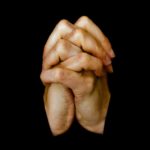The 70th Anniversary of General Patton's Famous Prayer

Army Signal Corps
This year marks not only the 70th anniversary of D-Day, but also the 70th anniversary of some of General George S. Patton’s greatest exploits as a commander during World War II. This week marks the anniversary of the General’s call for all the soldiers in his Third Army to pray, just as the last major Nazi offensive of World War II was about to begin.
Patton’s Third Army led the Allied break-out of Normandy in late July 1944. By the end of September, it stood poised to enter Germany after liberating much of France during its drive across Europe. However, what the Nazi Army could not do, the weather did. Europe’s unusually wet fall bogged down the Third Army and the rest of the Allied forces for the next two months, as they waited for the roads to dry.
The situation became so frustrating to Patton that on another rainy day in early December, he asked the Third Army head chaplain, James O’Neill, for a weather prayer. By O’Neill’s account, the General said the weather would need to change if they were going to win the war. The chaplain composed and delivered this prayer to Patton a short time later:
“Almighty and most merciful Father, we humbly beseech Thee, of Thy great goodness, to restrain these immoderate rains with which we have to contend. Grant us fair weather for battle. Graciously harken to us as soldiers who call upon Thee that armed with Thy power, we may advance from victory to victory, and crush the oppression and wickedness of our enemies, and establish Thy justice among men and nations. Amen.”

Patton liked it and ordered O’Neill to print 250,000 copies on prayer cards to distribute to the entire Third Army. On the reverse side of the cards was a Christmas greeting from the General. He then questioned the chaplain as to how much praying the Army was doing. O’Neill believed not much: when there’s fighting, everybody prays; but when it’s quiet, everyone just sits around and waits for things to happen.
Patton responded, “Chaplain, I am a strong believer in prayer. There are three ways that men get what they want; by planning, by working, and by praying. Any great military operation takes careful planning, or thinking. Then you must have well-trained troops to carry it out; that’s working. But between the plan and the operation there is always the unknown. That unknown spells defeat or victory, success or failure. It is the reaction of the actors to the ordeal when it actually comes. Some people call it getting the breaks; I call it God. God has His part, or margin in everything. That’s where prayer comes in.”
He added, “A good soldier is not made merely by making him think and work. There is something in every soldier that goes deeper than thinking or working—it’s his ‘guts.’ It is something that he has built in there: it is a world of truth and power that is higher than himself.” Patton referred to the account of Gideon in the Bible who, despite being greatly outnumbered, fought bravely and prevailed because the Lord was with him. (Judges, Chapters 6-8). The General observed that his men should be praying, wherever they were—or eventually they would “crack up.”
Patton instructed O’Neill to put out a training letter for all the chaplains in the Third Army on the importance of prayer. It was circulated to the Third Army’s 486 chaplains and to every organizational commander down to the regimental level—3,200 letters. Recounting how God aided Gideon’s army, O’Neill exhorted his fellow chaplains, “We must urge, instruct, and indoctrinate every fighting man to pray as well as fight. In Gideon’s day, and in our own, spiritually alert minorities carry the burdens and bring the victories.”
O’Neill’s training letters and prayer cards went into the Third Army’s ranks starting December 12, 1944. Events on the battlefield turned dramatically on December 16.
Nearly one hundred miles to the north of Patton’s Third Army sector, Adolf Hitler pulled some of his best units from battling the Russians to participate in a bold strike which he hoped would both dishearten the Allies and buy him time to strengthen Germany’s defenses. Under thick cloud cover with snow falling, Hitler’s 200,000 troops advanced through Belgium’s Ardennes Forest. The Allies could not employ their air cover because of the weather. The massive German thrust enveloped thousands of Allied soldiers—including 11,000 from the 101st Airborne Division in Bastogne. The German commander ordered the surrounded unit to immediately surrender—to which the American commander, General Anthony McAuliffe, famously replied, “Nuts.” The German Army tried to break the hold on Bastogne while also pushing west, creating a 50-by-30-mile-wide bulge in the Allied lines.

Credit: History Dept., USMA, West Point
Prior to the Ardennes Offensive, Patton had his staff working on a contingency plan because he sensed the Germans might counterattack in the Bastogne region. Patton amazed all in the Allied planning meeting called by General Dwight D. Eisenhower by saying that his Army could attack with three divisions in seventy-two hours in the Bastogne region. His forces were currently eighty-five miles to the south, with a portion already engaging the enemy—and the muddy roads were now icy and snow packed. Eisenhower gave the unrelenting Patton the green light to implement his plan.
On the same day the German commander demanded the 101st Airborne’s surrender (December 22), Patton’s forces hit the southern edge of the bulge—still over thirty miles from the besieged city. Allied air cover remained grounded until the following day, December 23. That morning, around the time many of the Third Army’s soldiers had received the prayer cards, the weeks-long cloud cover finally broke to a clear, sunny, and crisp ten-degree Fahrenheit day. The clear weather meant the hard-pressed defenders of Bastogne could finally be re-supplied with ammunition and food by parachute airdrop while Allied fighter aircraft could strike German ground forces. Experiencing nearly three hundred casualties per day, the 101st could only hope to hold out a few more days.
Finally on December 26, a beautiful sight appeared in the distance: a Sherman tank bearing the American star. The advanced elements of Patton’s Third Army were on their way, carving a tenuous, narrow corridor to the 101st that would widen the next day.
The Third Army continued attacking the enemy throughout the sector. With the help of Allied units to the north, by the end of January they had completely pushed back the Bulge, continuing into Germany. Around this time General Patton saw Chaplain O’Neill and cracked him on the side of his steel helmet with his riding crop, saying to him, “Well, Padre, our prayers worked. I knew they would.” The chaplain knew it was Patton’s way of saying, “Well done.”
————————————————————————-
Randy DeSoto is a West Point graduate. While in the Army, he served as an armor officer in the 4th Infantry Division. The article is excerpted from his book We Hold These Truths, which focuses on how leaders have appealed to faith in God and the rights He grants during some of the nation’s most defining moments. Portions of this article first appeared in the Officers’ Christian Fellowship Quarterly newsletter Connected in the winter 2007-08 edition.
Listen to Randy DeSoto discuss Patton’s Prayer in a radio interview with Gregg Jackson:




